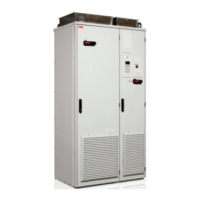Planning the electrical installation 79
Separate control cable ducts
Implementing short-circuit and thermal overload
protection
Protecting the inverter and AC output cable in short-circuit
situations
The inverter is equipped with internal AC fuses which restrict inverter damage in case of a
short-circuit inside the inverter. Install external protection (such as fuses) according to local
regulations, appropriate AC line voltage and the rated current of the inverter to protect the
AC output cable.
Protecting the photovoltaic generator and DC input cable in short-
circuit situations
The input DC fuses or optional DC input miniature circuit breakers (option +H377) protect
the inverter DC circuit and the DC input cables in a short-circuit situation when the cable is
dimensioned according to inverter nominal DC current and fuse and breaker ratings. See
section Fuses on page 127 for the fuse and breaker ratings.
To protect inverters delivered without input DC fuses (option +0F291), follow the
instructions in section Instructions for inverters delivered without input DC fuses (option
+0F291) on page 82.
Note: The inverter does not protect the photovoltaic generator. Install adequate protection
devices to, for example, each string.
Protecting the inverter and the AC output cable against thermal
overload
The inverter protects itself and the AC output cable against thermal overload when the
cable is dimensioned according to the nominal current of the inverter. No additional
thermal protection devices are needed.
24 V
24 V
230 V
Lead 24 V and 230 V (120 V) control
cables in separate ducts inside the
cabinet.
Not allowed unless the 24 V cable is
insulated for 230 V (120 V) or insulated
with an insulation sleeving for 230 V
(120 V).
(120 V)
230 V
(120 V)

